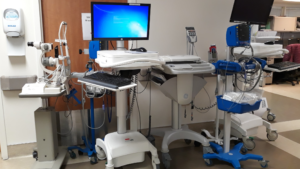
Preparing Your Healthcare WiFi Network for the Future Starts Now

The last year saw a lot of rapid advancements in healthcare technologies as facilities rushed to meet the demands of a nation treating a pandemic. While some facilities were already phasing in services like telemedicine and advanced monitoring, others found themselves starting from the ground floor. No matter which category they fell under though, all facilities know this – there’s no turning back. New applications, rapidly evolving demands, and higher patient expectations will be the basis for healthcare technology moving forward, and this creates serious demand for issue-free WiFi networks.
The Backbone of Healthcare
WiFi networks must be able to support:
- Patient monitoring
- Patient tracking
- Financial transactions
- Staff communications
- Telemedicine
- Security devices
- Building automation
- Guest devices
These applications – especially the ones that depend on real-time data and video – require high amounts of bandwidth and low latency for consistent, reliable, high-performance. If there are WiFi dead spots, spotty connections, or other issues, patient health can be seriously impacted. The network therefore has to be more than simply ready to support all current needs – it must be optimized to eliminate problems in real-time and proactively future-proofed to continue excelling no matter what happens.
Better Care and Better Control
A WiFi network that can be optimized in real-time increases operational efficiency and quality of care, improves patient and staff satisfaction, and boosts a facility’s reputation. The ability to stay ahead of network issues and resolve them proactively – before end users are affected – improves the chances of avoiding large failures and provides significant savings for all medical institutions.
In a world where WiFi networks are only growing more important and where rapid advancements are often expected to be in place overnight, these successes are vital for any facility. Achieving them is simpler with WiFi Automation.
WiFi Automation platforms automate the optimization process and reduce the burden on IT teams by providing:
- Complete RF ecosystem visibility
- Real-time alerts
- End User Quality Metrics
- Historical graphs with trends over time
- Remote troubleshooting
Eliminate Network Mysteries with Visibility
WiFi networks support hundreds or thousands of devices and transmit more data packets a second than humans can compute. In addition, these networks exist in the unlicensed WiFi spectrum. This means that the spectrum is open to use by any WiFi device – whether that device was designed by someone with expert level knowledge of network complexities or not. Finally, because WiFi operates in a shared medium – the airspace – network performance can be influenced by non-WiFi devices and nearby networks operating in the same airspace.
This all creates a complex, constantly evolving ecosystem that must be understood before it can be optimized. To provide that understanding, the Wireless Intelligence Platform™ (WIP) gives network administrators complete visibility into the entire RF ecosystem: all network devices and infrastructure, non-WiFi devices like microwaves and Bluetooth devices, and any nearby networks causing interference.
This complete visibility involves classification of APs and clients using device fingerprinting, as well as behavioral profiling and device pattern recognition. Thanks to these capabilities, IT teams know exactly which devices are connected to the network and why they are using the network. They also know immediately if all APs on the network belong to the healthcare facility, or if any unauthorized APs are impacting network performance.
Facilities wouldn’t allow strange doctors or nurses to wander the corridors, performing who knows what task. The same rules apply to the mission-critical WiFi network. Know exactly what your network is supporting with complete visibility and use that knowledge to determine how to best grow and upgrade the network.
Faster Problem Resolution with Real-Time Alerts
As networks continue rapidly evolving with new devices and applications becoming available every day, real-time alerts ensure that IT will know immediately if any network updates have created a problem for end users. Eliminating a problem before it’s had time to become a problem and affect end users is one of the fastest ways to improve network performance.
With its leading-edge AI engine, WIP provides instant alerts if network behavior changes in any way. Root cause identification and actionable resolutions are provided with all alerts to reduce the Mean-Time-to-Resolution by 90% and reduce problem tickets by 60%. The platform also provides real-time alerts if any of its scheduled network tests fail or fall below established parameters.
The network is going to change – whether due to new IoT devices connecting, APs needing upgrades, the rearranging of hospital floors, or any other number of factors. Stay ahead of changes every step of the way and optimize the network in real-time with WiFi Automation.
Cost-Effective Capacity Planning with Historical Analytics
One of the best ways to plan for the future is by studying the past. Over the last year, how has your WiFi network changed? For example:
- Has end user experience been impacted?
- Did AP performance slow?
- Did client distribution change?
- Did network utilization change?
- How did interference and noise level fluctuate?
If you have the answers on hand, you are in a good position to make insightful decisions about what upgrades/updates the network needs to provide optimal service for the next few years. This allows you to personalize the optimization process for your facility’s needs, and to do so cost-effectively.
If you don’t have the answers, or have to gather and save analytics manually throughout the year in a time consuming manner, work with a WiFi Automation platform that automatically saves historical device forensics.
With these analytics, IT can review past data throughout the year – perhaps when needing to resolve a problem that occurred when no one was onsite – and can review long-term trends and make the best decisions that will drive network efficiency moving forward.
Save Time and Reduce Remote Site Visits with Remote Capabilities
Whether responsible for a sprawling hospital, or multiple remote clinics, IT teams can’t be everywhere at once. This can result in a delay in problem resolution as teams travel to the site of a reported network problem, not to mention expensive travel costs. These problems are compounded when IT can’t travel, either because of illness, weather, or other challenges. The only solution then is to ask someone onsite to run tests, and try to walk them through problem resolution.
This is why we recommend a WiFi Automation platform with remote capabilities.
No more walking around sites trying to manually capture data, no more trying to talk someone through a test over the phone. With remote testing and troubleshooting, IT can optimize the network from any location at any time. If you’re using WIP, the sensor connects to the network as a client device when running tests, ensuring that all results exactly match the end user experience. Facilities using the platform reduce remote site visits by 80%.
Plan for the Future Now
Technology changes quickly and healthcare is changing right along with it. Ensure that your facility is ready for those changes no matter what with a WiFi Automation platform.
Learn more about the Wireless Intelligence Platform here.

